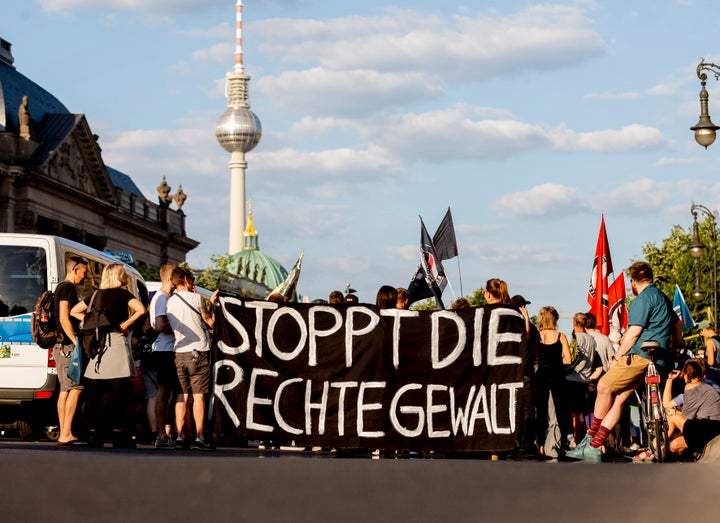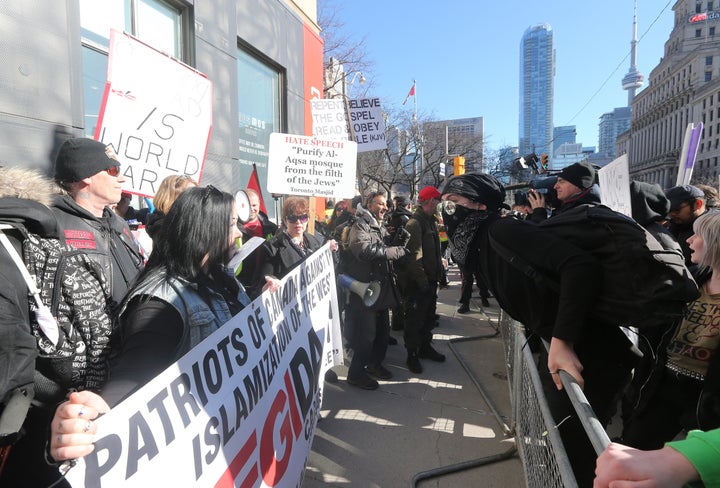From Pittsburgh to Poway to El Paso, U.S. law enforcement is struggling to deal with far-right domestic terrorism. FBI Director Christopher Wray said last month that white supremacy was responsible for the majority of domestic terror related arrests since the start of 2019 ― and still there’s no clear plan to stem the violence.
“Right now there is no strategy to combat the threat of domestic terrorism and extremism, period,” said George Selim, a former Department of Homeland Security official who focused on countering extremism and is now at the Anti-Defamation League. “There just is no comprehensive strategy or significant pool of dedicated funds to address today’s threats.”
American officials could look overseas for inspiration. For years, other Western democracies have tracked how violence can explode from movements that describe nonwhites as dangerous outsiders and establishment politics as betraying the “real” citizens of the homeland. They have responded by investing in programs to help steer people away from far-right extremist groups and ideologies and crafting new ways to crack down on the most likely offenders.
No country has figured out a perfect model for preventing extremism ― and both the right and the left in many countries have been critical of efforts to do so ― but a survey of similar nations suggests the U.S. has a lot of catching up to do.
The Softer Touch
Germany is probably the country “that’s been doing things the most effectively” when it comes to combating far-right extremism, according to Elizabeth Pearson, a University of Swansea lecturer who researches ways to counter violent extremism.
Given its dark history and evidence of a persistent threat like the assassination this summer of a politician challenging racism against refugees, the country has for decades been home to groups trying to limit the reach of neo-Nazis and their fellow travelers ― and to keep an eye on far-left extremism also responsible for violence within living memory.
Most organizations are focused on grassroots outreach; they aren’t controlled by the central government and instead work with regional administrations, often in areas that local communities or national attention flag as hot spots, Pearson said. Earlier this year, Daniel Koehler of the German Institute on Radicalization and De-radicalization Studies wrote that a “vast” number of local programs try to intervene with people vulnerable to right-wing extremism before they’re radicalized, citing a 2016 study that showed 267 projects are focused on the far-right.
Pearson noted the benefit of directing resources to counselors in the areas they’re already rooted in. “They’re able to reach into those communities,” she said, citing anecdotal evidence she’s heard in focus groups where people have shared their experiences.
German tactics also include training teachers to identify and connect with potential recruits for far-right extremism, as well as anti-radicalization efforts in youth programs for sports and the arts, per Cynthia Miller-Idriss, an education and sociology professor at American University.

Groups in Sweden, Denmark and the United Kingdom have also focused on direct communication with people flirting with extremist organizations. They use tactics like long-term one-on-one mentoring and engaging individuals’ families about warning signs and keeping them socially integrated, according to a Europe-wide analysis by the Institute for Strategic Dialogue think tank.
As counterextremism work has expanded, though, it’s shown its potential to go awry, most dramatically with post-9/11 legal regimes targeting Muslims in many Western democracies.
That’s become especially clear in the U.K.
In 2006, the year after the worst attack by violent Islamists in British history, London ramped up programs grouped under the title “Prevent” that largely focused on the risk of radicalization among the country’s Muslims. Beyond government-funded counseling, the scheme included a controversial requirement for public sector workers to flag people at risk to local authorities including the police.
Muslim and civil liberties advocates panned it as intrusive, discriminatory and likely to further alienate people.
After years of complaints, authorities have won over some of the skeptics. Prevent “has evolved, and from 2011 also looked at the far right,” Pearson said. “On top of that, evaluation of counterextremism programming is now an important part of Prevent. Initiatives need to be shown to work.”
But the old mistrust persists ― and other aspects of the government’s own approach undermine faith in the program.
“Many British Muslims still do not have confidence in Prevent,” Pearson said, because even as proponents of the approach point to its success and its reform, other parts of the state confirm the worst suspicions of the people the campaign is supposed to win over. British politicians have responded to growing nationalism with nativist rhetoric and telling undocumented immigrants to “go home or face arrest,” and Prevent has in some cases been linked to harsh measures ― like when families contacting police on advice from the program have seen the relatives they sought to help get long jail terms.
Today, Prevent is central to Britain’s response to far-right radicalization.
In February, Ben Wallace, then a key minister overseeing the program and now the U.K.’s defense secretary, told visiting reporters that right-wing extremists are now the country’s second-biggest terror threat. And they appear to feel empowered, with groups fixated on different forms of bigotry, from Islamophobia to anti-Semitism, finding ways to collaborate. In 2018, the year after a major car attack outside a mosque in London, referrals to Prevent for potential right-wing extremism surged by 36%.
The program’s old problems, though, could continue to limit its effectiveness. There’s a clear contradiction between mainstream politicians saying they want to keep a lid on far-right extremism and simultaneously keeping anti-immigrant views and policies in the public conversation, and there’s a risk that typecasting another group of people as worthy of special attention will just lead to more polarization.
“Things have got to join up, there has to be a coherent strategy across policing, Prevent, and political rhetoric ... and if they don’t join up then people can feel that they’re being targeted,” Pearson said. “One response has been to prioritize the far-right. This is a good aim, but it has to be done for the right reasons, not in an attempt to gain the trust of British Muslims by focusing on white working-class communities in the wake of bad past policy that’s caused harm. Extremism is a really complex issue and countering it is much easier to get wrong than to get right.”
Targeting International Far-Right Networks
Earlier this year, for the first time in its history, Canada added two far-right extremist groups, Blood & Honour and Combat 18, to its list of foreign terror organizations. Designating them as “proscribed entities” signaled that the government intended to take white supremacist violence seriously and made it easier for authorities to prosecute extremists associated with the groups. The designation allows Canadian authorities to track a banned group’s finances and seize any assets they may have, and also compels financial institutions to investigate if any of their clients are associated with the group.
Following Canada’s lead and adding violent far-right extremists to the U.S. State Department’s list of foreign terrorist organizations would give law enforcement new ways to investigate or prosecute American extremists who affiliate with or support white supremacists internationally. There are currently 67 organizations on the list, Vice notes, most of which are Islamist extremist groups.
Much as Islamic State supporters in the U.S. can be charged with providing material support to a terrorist organization for acts such as attempting to join the group or donating money to it, American white nationalists meeting up with or funding neo-Nazis abroad could face similar charges if far-right groups were included in the foreign terror list.
“The listing process really tells all Canadian national security organizations that the government considers it to be a terrorist organization, which means that a variety of different analytic and investigative resources can be leveraged,” said Jessica Davis, a former Canadian Security Intelligence Service analyst.

Canada’s move was celebrated by extremism experts and security officials, who had long been advocating for similar designations in the past. They also expect that the number of banned far-right groups is likely to grow, given that there are numerous extremist organizations that meet the bar for inclusion on the list ― including the U.S.-based neo-Nazi Atomwaffen Division, which has been linked to multiple murders.
Although many of the white supremacists who have carried out killings in the U.S. have not been part of an established group, the wider extremist network they are part of is global and interconnected. Attempting to curb the internationalization of white supremacy and block Americans from contributing to it would bring the U.S. in line with a growing trend among other nations looking to fight extremism.
“We’re definitely going to see more listings of far-right terrorist organizations, very likely here in Canada, as well as in Europe, Australia, New Zealand,” Davis said.
The U.S. Disengages From Countering Extremism
As governments and organizations elsewhere have moved to prevent radicalization and violent extremism in their countries, the U.S. has moved backward.
The Trump administration gutted funding and staff for programs countering violent extremism and disbanded a group of intelligence analysts focused on domestic terrorism. Trump appointees at DHS, like Customs and Border Protection spokeswoman Katie Gorka, worked to defund partnerships addressing mental health in Muslim communities and programs that help white supremacists leave the movement. They additionally suggested, bereft of evidence, that anti-fascist groups were the real threat.
The Trump administration has ignored far-right extremism almost entirely, despite years of warnings about the threat that white supremacist groups pose. Those include a rise in activity after Barack Obama’s election as president and the proliferation of racist conspiracy theories such as birtherism, which Trump played a prominent role in stoking.
Given the way Trump makes nativist diatribes central to his political message, it can be difficult for ostensibly apolitical law enforcement agencies to call out right-wing messaging as dangerous.
“I think in many ways the FBI is hamstrung in trying to investigate the white supremacist movement like the old FBI would,” Dave Gomez, a former FBI supervisor dealing in terrorism cases, told The Washington Post this week. “There’s some reluctance among agents to bring forth an investigation that targets what the president perceives as his base. It’s a no-win situation for the FBI agent or supervisor.”
Experts say this is a problem worldwide given the continued rise of nativism. “As the whole global political landscape has shifted more towards right-wing populist groups … that makes the far-right at this current time more difficult to define and more difficult to deal with,” Pearson said. Calling out the ideology and countering it is especially challenging, because unlike, say, Islamist narratives, ideas of white power and virulent nationalism can be presented as natural extensions of national values in Western countries, and therefore far more mainstream, she added.
This perhaps calls for an almost technocratic approach to mitigating far-right violence that steers clear of explicit politics ― and doesn’t trample civil liberties by arresting people for espousing certain “dangerous” views.
“What’s needed is not an authority to particularly charge someone who has engaged in extremist rhetoric an online forum ― what we need is a suite of prevention programs,” Selim said. “That’s where the biggest deficit is in our domestic homeland security approach right now, is just the severe reduction of both resources, staffing and strategy that this administration has systematically decimated.”